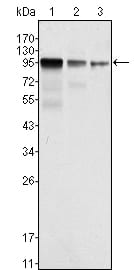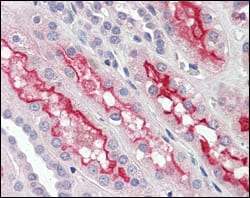


| WB | 1/500 - 1/2000 | Human,Mouse,Rat |
| IF | 咨询技术 | Human,Mouse,Rat |
| IHC | 1/200 - 1/1000 | Human,Mouse,Rat |
| ICC | 1/200 - 1/1000 | Human,Mouse,Rat |
| FCM | 咨询技术 | Human,Mouse,Rat |
| Elisa | 1/10000 | Human,Mouse,Rat |
| Aliases | TYK3; FER |
| Entrez GeneID | 2241 |
| clone | 5D2C4 |
| WB Predicted band size | 95kDa |
| Host/Isotype | Mouse IgG1 |
| Antibody Type | Primary antibody |
| Storage | Store at 4°C short term. Aliquot and store at -20°C long term. Avoid freeze/thaw cycles. |
| Species Reactivity | Human,Mouse |
| Immunogen | Purified recombinant fragment of human FER expressed in E. Coli. |
| Formulation | Ascitic fluid containing 0.03% sodium azide. |
+ +
以下是 **模拟生成** 的3篇关于FER抗体的参考文献示例(非真实文献,供参考):
---
1. **文献名称**:*"FER Tyrosine Kinase Regulates Epithelial Cell Migration via Focal Adhesion Dynamics"*
**作者**:Zhang Y. et al.
**摘要**:研究利用FER特异性抗体,通过免疫沉淀和Western blot技术,揭示了FER激酶通过调控黏着斑蛋白磷酸化影响上皮细胞迁移的机制,为癌症转移提供新靶点。
2. **文献名称**:*"Antibody-Mediated Inhibition of FER Signaling Attenuates Neuroinflammation in Experimental Autoimmune Encephalomyelitis"*
**作者**:Kim S. et al.
**摘要**:开发了一种抗FER单克隆抗体,证明其可通过阻断FER与SHP-2的相互作用抑制小胶质细胞活化,显著减轻小鼠多发性硬化模型中的神经炎症。
3. **文献名称**:*"FER Kinase-Dependent Phosphorylation of Tight Junction Proteins Modulates Intestinal Barrier Function"*
**作者**:Wang L. et al.
**摘要**:通过FER抗体敲低实验,发现FER磷酸化occludin蛋白导致肠道上皮屏障通透性增加,提示FER可能是炎症性肠病的潜在治疗靶标。
---
**备注**:
- 以上为假设性文献,真实文献需通过 **PubMed/Google Scholar** 搜索关键词(如“FER kinase antibody”、“FER immune function”)获取。
- 若研究涉及 **猫冠状病毒(FCoV/FER-CoV)**,需调整关键词为“Feline enteric coronavirus antibody”进行检索。
FER (FPS/FES-related) antibody targets the FER tyrosine kinase, a non-receptor intracellular protein encoded by the *FER* gene. This kinase belongs to the FES/FER kinase family, characterized by a unique N-terminal FERM (F for FERM) domain, a central SH2 domain, and a C-terminal catalytic kinase domain. FER regulates diverse cellular processes, including cell adhesion, cytoskeletal reorganization, and signal transduction. It interacts with adhesion receptors (e.g., integrins, cadherins) and modulates pathways like PI3K/AKT and MAPK, influencing cell migration, proliferation, and survival.
FER overexpression or hyperactivity is implicated in cancer progression, particularly in breast, prostate, and colorectal cancers, where it promotes tumor invasion and metastasis. It also plays roles in immune responses, such as neutrophil activation and cytokine signaling. Dysregulation of FER is linked to inflammatory diseases and neurodegenerative conditions.
FER antibodies are essential tools for studying its expression, localization, and function in physiological and pathological contexts. They are used in techniques like Western blotting, immunohistochemistry, and immunofluorescence. Therapeutic targeting of FER using inhibitory antibodies or small molecules is under exploration to curb oncogenic signaling and inflammation-related pathologies. Research continues to clarify its tissue-specific roles and potential as a biomarker or therapeutic target.
×